ISSN: 1839-9940
J Genomics 2018; 6:103-112. doi:10.7150/jgen.20581 This volume Cite
Research Paper
Expression and network analysis of YBX1 interactors for identification of new drug targets in lung adenocarcinoma
1. Department of Biotechnology, Motilal Nehru National Institute of Technology, Allahabad, India-211004.
2. Center of Bioinformatics, University of Allahabad, India-211002.
*All authors contributed equally.
Received 2017-4-15; Accepted 2017-8-31; Published 2018-6-26
Abstract

Y-Box Binding protein 1 (YBX-1) is known to be involved in various types of cancers. It's interactors also play major role in various cellular functions. Present work aimed to study the expression profile of the YBX-1 interactors during lung adenocarcinoma (LUAD). The differential expression analysis involved 57 genes from 95 lung adenocarcinoma samples, construction of gene network and topology analysis. A Total of 43 genes were found to be differentially expressed from which 17 genes were found to be down regulated and 26 genes were up-regulated. We observed that Polyadenylate-binding protein 1 (PABPC1), a protein involved in YBX1 translation, is highly correlated with YBX1. The interaction network analysis for a differentially expressed non-coding RNA Growth Arrest Specific 5 (GAS5) suggests that two proteins namely, Growth Arrest Specific 2 (GAS2) and Peripheral myelin protein 22 (PMP22) are potentially involved in LUAD progression. The network analysis and differential expression suggests that Collagen type 1 alpha 2 (COL1A2) can be potential biomarker and target for LUAD.
Keywords: YBX1, regulatory network, lung adenocarcinoma, RNA-Seq.
Introduction
Lung Adenocarcinoma, a subtype of non-small cell lung cancer is the most pervasive among lung cancers leading to the death of millions of people each year [1, 2]. Though the recent therapy for the lung adenocarcinoma with mutated EGFR and rearranged ALK have been significant [3, 4], but the other driving force for the progress of lung adenocarcinoma have not been deciphered much. The type of interaction among the gene and its environment decides their role in disease progression [5, 6]. Understanding the gene interactions and its importance in the regulation mechanism is necessary to identify a potential target for therapeutic application.
In this study, we analyzed the expression of Y- box binding protein 1 (YBX1) and its interactors in lung adenocarcinoma (LUAD). YBX1 belongs to the Y-box binding protein family with a highly conserved cold shock domain and known to be involved in various eukaryotic cellular mechanisms [7-9]. YBX1 is usually involved in RNA splicing and translational mechanism in cytoplasm but, it translocates to nucleus and gets involved in transcriptional regulation during stress condition [10-13]. It is associated with drug resistance, cell proliferation and cell death [14]. The transcription factor of YBX1 binds to the E-box for regulating it [15].
YBX1 is over expressed in various cancers and it has been suggested as biomarker in prognosis of various cancer types [16, 17]. Multi drug resistance and metastasis are major reason for it's over expression [18, 19]. YBX1 interactors are known to be involved in various cellular mechanisms ranging from cell signaling, DNA and protein repair mechanism to transcriptional regulation [20-26]. Genes which are known to be involved in regulation of YBX1 as well as those regulated by YBX1 has been listed in (Table 1).
In this study we investigated the role of YBX1 and its interactors in Lung adenocarcinoma by looking at their expression profile and constructed gene regulatory network in order to decipher their importance in network formation by a system biological approach.
Genes regulates and regulated by YBX1
| Gene- Id | Gene | Reference |
|---|---|---|
| Genes Up- Regulates YBX1 | 4904 | ||
| TP73 | 7161 | Tumor Protein 73 | [17] |
| MYC | 4609 | v-myc avian myelocytomatosis viral oncogene homolog | |
| MAX | 4149 | MYC Associated Factor X | |
| TWIST1 | 7291 | Twist basic helix-loop-helix transcription factor 1 | [14] |
| PABPC1 | 26986 | Poly(A) binding protein, cytoplasmic 1 | [18] |
| GATA1 | 2623 | GATA binding protein 1 | [19] |
| GATA2 | 2624 | GATA binding protein 2 | |
| PTGER1 | 5731 | Prostaglandin E receptor 1 (subtype EP1) | [20] |
| SHH | 6469 | Sonic Hedgehog | [21] |
| Genes Down- Regulates YBX1 | 4094 | ||
| FOXO3 | 2309 | Forkhead Box 03 | [15] |
| ILK | 3611 | Integrin linked kinase | [16] |
| TGFB1 | 7040 | Transforming growth factor, beta 1 | [22] |
| C1QBP | 708 | Complement component 1, q subcomponent binding protein | [23] |
| GAS5 | 60674 | Long non coding RNA growth arrest specific transcript 5 | [24] |
| KAT2B | 8850 | K (lysine) acetyltransferase 2B | [25] |
| Genes Activated by YBX1 | 4904 | ||
| CCL5 | 6352 | Chemokine (C-C motif) ligand 5 | [26,27] |
| CD44 | 960 | CD44 molecule | [28] |
| ITGA6 | 3655 | Integrin, alpha 6 | |
| MMP2 | 4313 | Matrix metallopeptidase 2 | [29,30] |
| POLA1 | 5422 | Polymerase (DNA directed), alpha 1, catalytic subunit | [31] |
| EGFR | 1956 | Epidermal growth factor receptor | [32] |
| ERBB2 | 2064 | V-erb-b2 avian erythroblastic leukemia viral oncogene homolog 2 | |
| MET | 4233 | Met proto-oncogene | [33] |
| ABCB1 | 5243 | ATP-binding cassette, sub-family B (MDR/TAP), member 1 | [34,35] |
| MVP | 9961 | Major vault protein | [36] |
| PDGFB | 5155 | Platelet-derived growth factor beta polypeptide | [37] |
| PTPN1 | 5770 | Protein tyrosine phosphatase, non-receptor type 1 | [38] |
| SMAD7 | 4092 | SMAD family member 7 | [39] |
| CCNA1 | 8900 | Cyclin A1 | [40] |
| CCNA2 | 890 | Cyclin A2 | |
| CCNB1 | 891 | Cyclin B1 | |
| PIK3CA | 5290 | Phosphatidylinositol-4,5-bisphosphate 3-kinase, catalytic subunit alpha | [41] |
| Genes Repressed by YBX1 | 4904 | ||
| ACTA1 | 58 | Actin, alpha 1, skeletal muscle | [42,43] |
| COL1A1 | 1277 | Collagen, type I, alpha 1 | [44,45] |
| COL1A2 | 1278 | Collagen, type I, alpha 2 | [46] |
| CPS1 | 1373 | Carbamoyl-phosphate synthase 1, mitochondrial | [47] |
| FAS | 355 | Fas cell surface death receptor | [5] |
| CSF2 | 1437 | Colony stimulating factor 2 (granulocyte-macrophage) | [48,49] |
| HSPA5 | 3309 | Heat shock 70kda protein 5 | [50] |
| MMP12 | 4321 | Matrix metallopeptidase 12 | [51] |
| MMP13 | 4322 | Matrix metallopeptidase 13 | [52] |
| HLA-A | 3105 | Major histocompatibility complex, class I, A | [53] |
| HLA-B | 3106 | Major histocompatibility complex, class I, B | |
| HLA-C | 3107 | Major histocompatibility complex, class I, C | |
| HLA-E | 3133 | Major histocompatibility complex, class I, E | |
| HLA-F | 3134 | Major histocompatibility complex, class I, F | |
| HLA-G | 3135 | Major histocompatibility complex, class I, G | |
| HLA-DRA | 3122 | Major histocompatibility complex, class II, DR alpha | [54-56] |
| B2M | 567 | Beta-2-microglobulin | |
| HLA-DQB1 | 3119 | Major histocompatibility complex, class II, DQ beta 1 | |
| ABCC2 | 1244 | ATP-binding cassette, sub-family C (CFTR/MRP), member 2 | [57] |
| CDKN1A | 1026 | Cyclin-dependent kinase inhibitor 1A (p21, Cip1) | [58] |
| TP53 | 7157 | Tumor protein p53 | [59] |
| TSHR | 7253 | Thyroid stimulating hormone receptor | [60] |
| VEGFA | 7422 | Vascular endothelial growth factor A | [61,62] |
| SOX2 | 6657 | SRY (sex determining region Y)-box 2 | [63] |
Materials and Methods
RNA Seq data and Sample Quality Analysis
The Cancer Genome Atlas (TCGA) RNA-Seq level 3 data for YBX1 and its interactors belonging to 116 normal and normal matched tumor samples in LUAD were downloaded from Broad Genome Data Analysis Center (GDAC) Firehose site (https://gdac.broadinstitute.org/). RNA Sequence by Expectation Maximization (RSEM) [69] counts for 57 genes of our interest including YBX-1 were used for differential expression analysis.
Principle Component Analysis (PCA) and hierarchical clustering with log transformed datasets of the samples were performed using R-Bioconductor [70,71] package DESeq2 [72] to estimate sample dispersion and to filter out the outlier.
Differential Expression (DE) Analysis and Correlation between genes
R-Bioconductor package DESeq2 was used to carry out differential expression analysis with nbionom Wald test for calculating logarithmic fold change and Benjamini- Hochberg method [73] for estimating adjusted-p value. Genes with adjusted-p value less than 0.05 were considered as differentially expressed. Correlation between differentially expressed genes was calculated with Pearson Correlation method using R package Hmisc [74] and the plot for the correlation coefficient was constructed using R package Corrplot [75].
Gene Regulatory Network Construction and Analysis
Gene regulatory network was constructed for the 56 genes omitting GAS5 using the GeneMANIA [76] with maximum resultant gene and attributes to enrich were 30 and 215 respectively. And the constructed network was analyzed for its network topology by looking at its parameters like closeness centrality, betweenness centrality and degree with network analysis tool in Cytoscape 3.4 [77]. RAIN (RNA - protein Association and Interaction Network) [78] was used to identify interactors for the long non-coding RNA (lncRNA) GAS5. And Search Tool for Retrieval of Interacting Genes (STRING) database [79] was used to analyze the network and the interactions with confidence level of 0.7 were considered significant. Network with not more than 10 interactors for the GAS5 was constructed.
Gene Set Enrichment Analysis
Functional enrichment for the genes common to both differentially expressed gene sets and hub genes from network was done by using Database for Annotation, Visualization and Integrated Discovery (DAVID) [80]. Gene Ontology (GO) database [81] provides the annotation for the gene set and Reactome pathway [82] illustrate the pathways in which the genes were involved. With DAVID tool we analyzed the gene set in both GO and Reactome pathway with p-value < 0.05 and gene-count > 3 as condition for enrichment analysis.
Results
Assessment of Sample Quality and Filtering
In this study, we initially took 116 LUAD samples with TCGA level-3 data. With Principle Component Analysis (PCA) and hierarchical clustering removed samples whichever showed variation within its group (Figure S1). And we plotted again PCA and hierarchical clustering for the final 95 samples with 57 genes. After filtering, two methods now able to distinguish the samples based on their conditions- normal or tumor (Figure 1).
Differential Expression Analysis and Correlation between Genes
The 43 genes which have adjusted-p value less than 0.05 were selected as differentially expressed with GATA1 having a high negative fold change (-1.91476) and MMP13 having a high positive fold change (5.81790). And correlation matrix between the differentially expressed genes was constructed and the correlation coefficient with p-value less than 0.05 were considered significant (Figure 2). YBX1 showed a maximum positive correlation with C1QBP (0.592) and negative correlation with HLA-E (-0.281) (Table S1).
Gene Network Construction and Analysis
Gene network was constructed and analyzed (Figure 3), it has 86 nodes and 3611 interactions (Table 2). Top 10 genes involved in the network formation were selected based on the topology parameter-degree, betweenness centrality and closeness centrality (Table 3). The attributes from GeneMANIA showed cancer pathways hold 15.34% in network with involvement of 17 genes (Table 4).
As GeneMANIA construct network and interactions for the coding gene, it was not able to predict for GAS5. So RAIN database which identify the interactors for non-coding RNA was used to identify interactors of GAS5. Total 10 interactors were found and the network was constructed between the genes with confidence level of 0.7 using STRING database (Figure 4)
Quality of the samples after filtering. (1A) Heatmap shows the unsupervised hierarchical clustering of the normal and tumor samples in LUAD after filtration. The row represents the genes and column represent the samples. Normal and tumor samples are clustered within their group based on their Euclidean distance. (1B) Principle Component Analysis for the filtered samples shows that first principle component (PC1) separates the normal and tumor samples. In both analysis, samples are found to be grouped within their type.
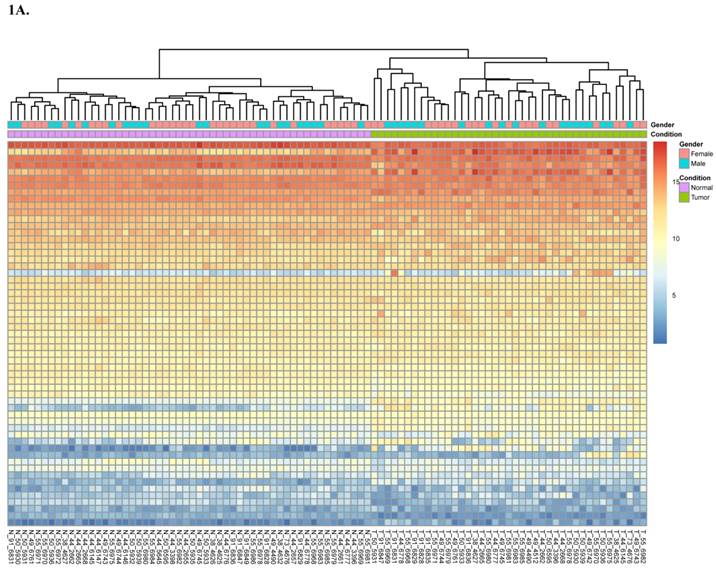
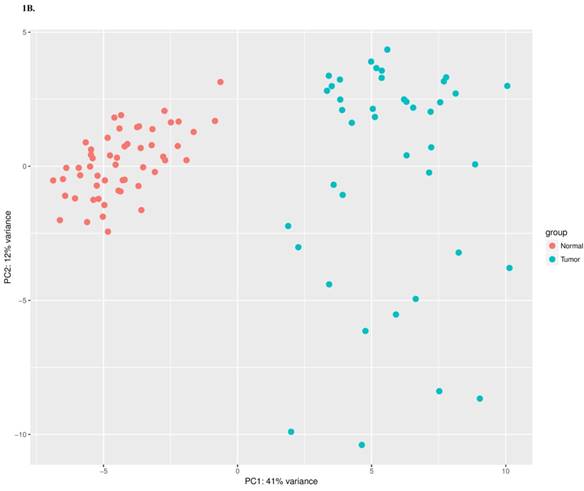
Correlation plot between the differentially expressed genes in LUAD. Correlation with the significance p- value (<0.05) are shown. Insignificant correlation are left blank without colors.
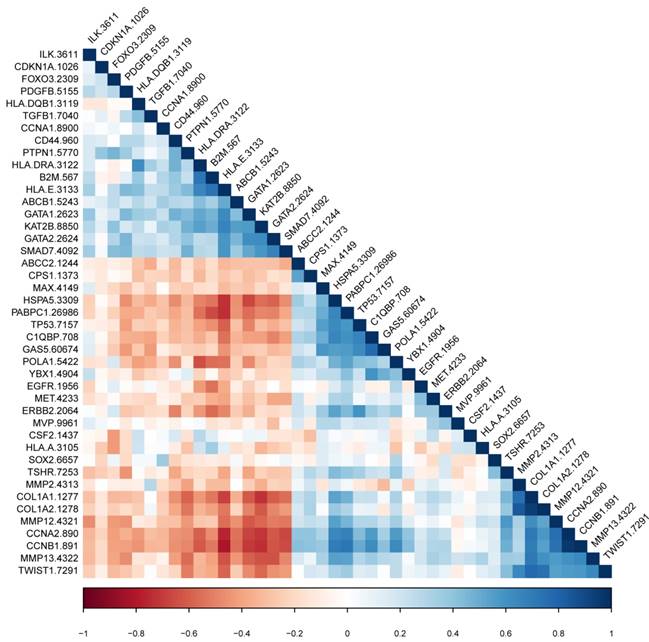
Interaction type and number of interactions in the network constructed by GeneMANIA
| Type of Interactions | Number of Interactions |
|---|---|
| Co-expression | 1761 |
| Co-localization | 116 |
| Genetic Interaction | 98 |
| Pathways | 182 |
| Physical Interaction | 462 |
| Predicted | 13 |
| Shared Protein Domain | 979 |
Gene Set Enrichment Analysis
The annotation of the gene with GO and Reactome pathways using DAVID resulted in a single cluster with genes enriched in GO- cellular components of proteinaceous extracellular matrix and extracellular region. GO- Biological process contained the collagen catabolic process and Reactome pathways included Generic transcriptional regulation. Only 3 genes were involved in the enrichment when the condition for enrichment was made high, namely- COL1A2, MMP12, MMP13. The enriched terms are shown in Table 5.
Central genes in Gene Regulatory network constructed using GeneMANIA and analyzed by Cytoscape- Network Analysis Tool. Top 10 gene with high Closeness Centrality, Betweenness Centrality and Degree.
| Genes | Closeness Centrality | Genes | Betweenness Centrality | Genes | Degree |
|---|---|---|---|---|---|
| MMP13 | 1.000 | HLA-DRA | 0.018 | HLA-DRA | 317 |
| YBX-1 | 1.000 | B2M | 0.017 | HLA-DMA | 274 |
| TSHR | 1.000 | HLA-A | 0.015 | HLA-A | 266 |
| ABCC2 | 0.800 | HLA-C | 0.014 | HLA-DPB1 | 266 |
| KATA2B | 0.750 | CDKN1A | 0.014 | HLA-DPA1 | 257 |
| ABCB1 | 0.750 | ILK | 0.014 | B2M | 255 |
| COL1A2 | 0.700 | HLA-B | 0.010 | HLA-G | 252 |
| CDKN1A | 0.689 | HLA-DMB | 0.010 | HLA-DMB | 246 |
| MMP 12 | 0.667 | VEGFA | 0.009 | HLA-F | 241 |
| MYC | 0.667 | HLA-DRB1 | 0.008 | HLA-DRB1 | 226 |
Gene network constructed and analyzed with Cytoscape. Directed root network built from the gene interaction data obtained from GeneMANIA. Network has 86 nodes with 3611 interactions. Figure 3A, 3B and 3C highlights the top 10 genes with closeness centrality, betweenness centrality and degree respectively. CDKN1A is the common gene between closeness centrality and betweenness centrality. Five genes namely, HLA-DRA, HLA-A, HLA-DRB1, HLA-DMB and B2M showed highest betweenness centrality and degree.

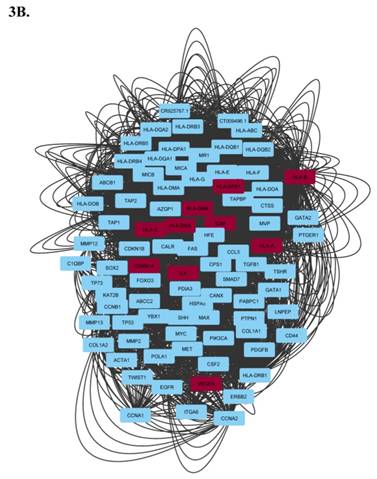
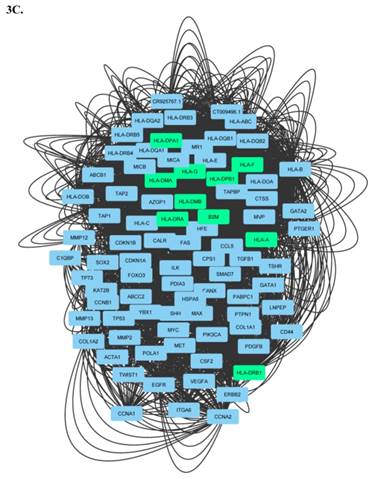
Interactors of GAS5 derived from RAIN database. Interaction with confidence level > 0.7 is considered as significant. Among the interactors GAS2 and PMP22 are the proteins involved in interaction with GAS5.
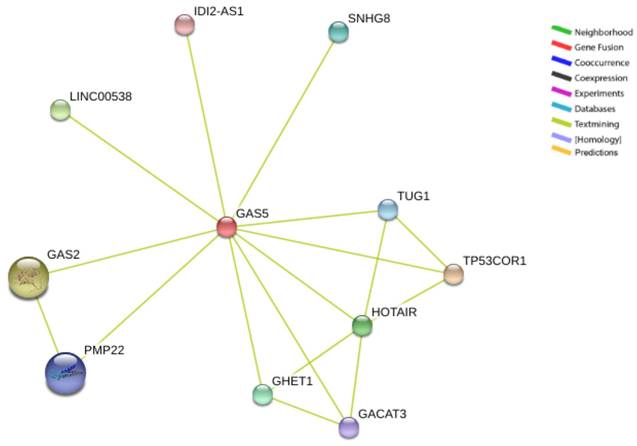
Genes involved in Cancer Pathways, known from GENEMANIA network attributes.
| Gene Id | Gene |
|---|---|
| CCNAI | 8900 | Cyclin A |
| VEGFA | 7422 | vascular endothelial growth factor A |
| MMP2 | 4313 | Matrix Metallopeptidase 2 |
| MET | 4233 | Met proto-oncogene |
| MAX | 4149 | MYC associated factor X |
| SHH | 6469 | Sonic hedgehog |
| TGFB1 | 7040 | Transforming Growth Factor, Beta 1 |
| ITGA6 | 3655 | Integrin, alpha 6 |
| FAS | 355 | Fas cell surface death receptor |
| TP53 | 7157 | Tumor Protein p53 |
| PDGFB | 5155 | Platelet-derived growth factor beta polypeptide |
| CDKN1A | 1026 | Cyclin-dependent kinase inhibitor 1A |
| ERBB2 | 2064 | v-erb-b2 avian erythroblastic leukemia viral oncogene homolog 2 |
| PIK3CA | 5290 | Phosphatidylinositol-4,5-bisphosphate 3-kinase, catalytic subunit alpha |
| EGFR | 1956 | Epidermal growth factor receptor |
| CDKN1B | | Cyclin-dependent kinase inhibitor 1B |
Gene Enrichment Analysis- Gene Ontology (GO) and Reactome Pathways (RP) enriched by genes common to differential expression and hub gene in the gene regulatory network.
| Group | Term | Gene Count | p-value |
|---|---|---|---|
| GO-BP | GO:0030574~collagen catabolic process | 3 | 1.419E-4 |
| GO-CC | GO:0005578~proteinaceous extracellular matrix | 3 | 0.002 |
| GO-CC | GO:0005576~extracellular region | 3 | 0.065 |
| RP | R-HSA-1442490:R-HSA-1442490 | 3 | 4.829E-4 |
Discussion
Despite of various studies carried out on YBX1, role of its interactors in lung adenocarcinoma have been less explored. YBX1 have been involved in the regulation of tumor progression in lung adenocarcinoma [83, 84], so understanding its interactions with other gene become a necessary to know their mechanism in disease progression and drug discovery. Our present study finds that YBX1 is up regulated with a low fold change (0.224). GATA 1 and GATA 2 which upregulate YBX1 level in erythroid cells [20] were found to be down regulated that indicates that they don't play major role in regulation of YBX1 in lung adenocarcinoma.
Among the genes which upregulate YBX1, PABPC1 which is involved in the translation of YBX1 mRNA [85] was found to be having high correlation (> 0.4) with YBX1 and it was significantly expressed with a fold change of 1.259. C1QBP which is known to be involved in prostate cancer progression [86] and a highly negative regulator of YBX1 in renal cell carcinoma [87] is highly correlated with YBX1 along with GAS5, a long non-coding RNA which involves in regulating cell death in prostate cancer [88]. Among the GAS5 interactors identified from RAIN database there are two proteins namely Growth Arrest Specific 2 (GAS2) and Peripheral myelin protein 22 (PMP22) which are known to be over expressed in colorectal cancer cell and breast cancer patients [89, 90] respectively. However the evidence regarding their role in LUAD disease progression needs to be explored for being a potential biomarker in LUAD identification and for therapeutic application.
Comparison of the differentially expressed genes and the hub genes in the network formation revealed that MMP13, ABCC2, MMP12, TSHR, COL1A2, PABPC1 and YBX1 are common among the both groups. Except for PABPC1, rest of the genes are usually repressed by YBX1, but in our study they are among the highly up regulated genes making a need for further study to understand their relationship between YBX1 in LUAD. Among the three genes involved in the enrichment, MMP12 and MMP13 are reported to be involved in the lung cancer in earlier studies [90- 94]. Significantly COL1A2 is involved in progress of gastric cancer [95] and in head and neck cancer [96]. It can serve as a potential biomarker in LUAD and its involvement in the disease progress need to be explored.
Conclusion
The study aimed to investigate the role of YBX1 and its interactors in lung adenocarcinoma by looking at their differential expression and network topology study. The study showed PABPC1 can be potential target in regulating YBX1. The lncRNA GAS5, whose role in the LUAD need to be explored and it can be a potential biomarker along with COL1A2.
Supplementary Material
Supplementary figures and tables.
Acknowledgements
AM is highly thankful to SERB New Delhi for a project grant. SNM is highly thankful to MNNIT Allahabad for a fellowship.
Competing Interests
The authors have declared that no competing interest exists.
References
1. Siegel R, Naishadham D, Jemal A. Cancer Statistics. 2013. CA Cancer J Clin. 2013;63:11-30
2. Jemal A, Bray F, Center MM, Ferlay J, Ward E, Forman D. Global Cancer Statistics: 2011. CA Cancer J Clin. 2011;61:69-90
3. Travis WD, Brambilla E, Riely GJ. New pathologic classification of lung cancer: Relevance for clinical practice and clinical trials. J. Clin. Oncol. 2013;31:992-1001
4. Yu KH, Snyder M. Omics Profiling in Precision Oncology. Mol. Cell. Proteomics. 2016;8:2525-2536
5. Hunter DJ. Gene - environment interactions in human diseases. Nat. Rev. Genet. 2005;6:287-298
6. Cordell HJ. Detecting gene - gene interactions that underlie human diseases. Nat. Rev. Genet. 2009;10:392-404
7. Didier DK, Schiffenbauer J, Woulfe SL. et al. Characterization of the cDNA encoding a protein binding to the major histocompatibility complex class II Y box. Proc. Natl. Acad. Sci. U. S. A. 1988;85:7322-7326
8. Makino Y, Ohga T, Toh S, Koike K. et al. Structural and functional analysis of the human Y-box binding protein (YB-1) gene promoter. Nucleic Acids Res. 1996;24:1873-1878
9. Matsumoto K, Bay B. Significance of the Y-box proteins in human cancers. J. Mol. Genet. Med. 2005;1:11-17
10. Holm PS, Bergmann S, Lage H, Brand K. et al. YB-1 Relocates to the Nucleus in Adenovirus-infected Cells and Facilitates Viral Replication by Inducing E2 Gene Expression through the E2 Late Promoter YB-1 Relocates to the Nucleus in Adenovirus-infected Cell. J. Biol. Chem. 2002;277:10427-10434
11. Sutherland BW, Kucab J, Wu J, Lee C. et al. Akt phosphorylates the Y-box binding protein 1 at Ser102 located in the cold shock domain and affects the anchorage-independent growth of breast cancer cells. Oncogene. 2005;24:4281-4292
12. Kohno K, Izumi H, Uchiumi T, Ashizuka M, Kuwano M. The pleiotropic functions of the Y-box-binding protein, YB-1. BioEssays. 2003;25:691-698
13. Lasham A, Lindridge E, Rudert F, Onrust R, Watson J. et al. Regulation of the human fas promoter by YB-1, Pura and AP-1 transcription factors. Gene. 2000;252:1-13
14. Homer A, Knight DA, Hananeia L, Sheard P. et al. Y-box factor YB1 controls p53 apoptotic function. Oncogene. 2005;24:8314-8325
15. Shiota M, Izumi H, Onitsuka T, Miyamoto N, Kashiwagi E. et al. Twist promotes tumor cell growth through YB-1 expression. Cancer Res. 2008;68:98-105
16. Shibao K, Takano H, Nakayama Y, Okazaki K. et al. Enhanced coexpression of YB-1 and DNA topoisomerase II alpha genes in human colorectal carcinomas. Int. J. Cancer. 1999;83:732-737
17. Bargou R, Jurchott K, Wargener C, Bergmann S. et al. Nuclear localization and increased levels of transcription factor YB-1 in primary human breast cancers are associated with intrinsic MDR1 gene expression. Nat. Med. 1997;3:447-450
18. Eliseeva IA, Kim ER, Guryanov SG, Ovchinnikov LP, Lyabin DN. Y Box Binding Protein 1 (YB 1 ) and Its Functions. Biochem. 2011;76:1402-1433
19. Kuwano M, Oda Y, Izumi H, Yang S. et al. The role of nuclear Y-box binding protein 1 as a global marker in drug resistance. Mol. Cancer Ther. 2004;3:1485-1492
20. Yokoyama H, Harigae H, Takahashi S, Kameoka J. et al. High expression of YB-1 gene in erythroid cells in patients with refractory anemia. Int. J. Hematol. 2003;78:213-218
21. Zhang H, Cheng S, Zhang M. et al. Prostaglandin e2 promotes hepatocellular carcinoma cell invasion through upregulation of YB-1 protein expression. Int. J. Oncol. 2014;44:769-780
22. Dey A, Robitaille M, Remke M, Maier C. et al. YB-1 is elevated in medullablastoma and drives proliferation in Sonic hedgehog- dependent cerebellar granula neuron progenitor cells and medulloblastoma cells. Oncogene. 2016;35:4256-4268
23. Kato M, Wang L, Putta S, Wang M. et al. Post-transcriptional up-regulation of Tsc-22 by Ybx1, a target of miR-216a, mediates TGF-beta-induced collagen expression in kidney cells. J. Biol. Chem. 2010;285:34004-34015
24. Wang Y, Yue D, Xiao M, Qi C. et al. C1QBP negatively regulates the activation of oncoprotein YBX1 in the renal cell carcinoma as revealed by interactomics analysis. J. Proteome Res. 2015;14:804-813
25. Liu Y, Zhao J, Zhang W, Gan J, Hu C, Huang G, Zhang Y. lncRNA GAS5 enhances G1 cell cycle arrest via binding to YBX1 to regulate p21 expression in stomach cancer. Sci. Rep. 2015;5:10159
26. Shiota M, Yokomizo A, Tada Y, Uchiumi T. et al. P300/CBP-associated factor regulates Y-box binding protein-1 expression and promotes cancer cell growth, cancer invasion and drug resistance. Cancer Sci. 2010;101:1797-1806
27. Uramoto H, Izumi H, Ise T, Tada M. et al. p73 interacts with c-Myc to regulate Y-box-binding protein-1 expression. J. Biol. Chem. 2002;277:31694-31702
28. Lyabin DN, Eliseeva I, Skabkina OV, Ovchinnikov LP. Interplay between Y-box-binding protein 1 (YB-1) and poly(A) binding protein (PABP) in specific regulation of YB-1 mRNA translation. RNA Biol. 2011;8:883-92
29. Shiota M, Song Y, Yokomizo A, Kiyoshima K, Tada Y, Uchino H. et al. Foxo3a suppression of urothelial cancer invasiveness through twist1, Y-box-binding protein 1, and E-cadherin regulation. Clin. Cancer Res. 2010;16:5654-5663
30. Kalra J, Sutherland BW, Stratford L, Dragowska W. et al. Suppression of Her2/neu expression through ILK inhibition is regulated by a pathway involving TWIST and YB-1. Oncogene. 2010;29:6343-6356
31. Krohn R, Raffetseder U, Bot I, Zernecke A, Shagdarsuren E. et al. Y-box binding protein-1 controls CC chemokine ligand-5 (CCL5) expression in smooth muscle cells and contributes to neointima formation in atherosclerosis-prone mice. Circulation. 2007;116:1812-1820
32. Raffetseder U, Rauen T, Djudjaj S, Kretzler M. et al. Differential regulation of chemokine CCL5 expression in monocytes/macrophages and renal cells by Y-box protein-1. Kidney Int. 2009;75:185-196
33. To K, Fotovati A, Reipas KM, Law JH, Hu K, Astanehe A. et al. YB-1 induces expression of CD44 and CD49f leading to enhanced self-renewal, mammosphere growth, and drug resistance. Cancer Res. 2010;70:2840-2851
34. Mertens PR, Harendza S, Pollock AS, Lovett DH. Glomerular mesangial cell-specific transactivation of matrix metalloproteinase 2 transcription is mediated by YB-1. J. Biol. Chem. 1997;272:22905-22912
35. Mertens PR, Alfonso-Jaume MA, Steinmann K, Lovett DH. A synergistic interaction of transcription factors AP2 and YB-1 regulates gelatinase A enhancer-dependent transcription. J. Biol. Chem. 1998;273:32957-32965
36. En-Nia A, Yilmaz E, Klinge U, Lovett DH, Stefanidis I, Mertens PR. Transcription factor YB-1 mediates DNA polymerase alpha gene expression. J. Biol. Chem. 2005;280:7702-11
37. Stratford AL, Habibi G, Astanehe A, Jiang H, Hu K. et al. Dunn, Epidermal growth factor receptor (EGFR) is transcriptionally induced by the Y-box binding protein-1 (YB-1) and can be inhibited with Iressa in basal-like breast cancer, providing a potential target for therapy. Breast Cancer Res. 2007;9:R61
38. Finkbeiner MR, Astanehe A, To K. et al. Profiling YB-1 target genes uncovers a new mechanism for MET receptor regulation in normal and malignant human mammary cells. Oncogene. 2009;28:1421-1431
39. Ohga T, Koike K, Ono M, Makino Y, Itagaki Y, Tanimoto M, Kuwano M, Kohno K. Role of the human Y box-binding protein YB-1 in cellular sensitivity to the DNA-damaging agents cisplatin, mitomycin C, and ultraviolet light. Cancer Res. 1996;56:4224-4228
40. Sengupta S, Mantha AK, Mitra S, Bhakat KK. Human AP-endonuclease (APE1/Ref-1) and its acetylation regulate YB-1/p-300 recruitment and RNA polymerase II loading in the drug induced activation of multidrug resistance gene MDR1. Oncogene. 2011;30:482-493
41. Stein U, Bergmann S, Scheffer GL, Scheper GJ, Royer HD, Schlag PM, Walther W. YB-1 facilitates basal and 5-fluorouracil-inducible expression of the human major vault protein (MVP) gene. Oncogene. 2005;24:3606-3618
42. Stenina OI, Shaneyfelt KM, DiCorleto PE. Thrombin induces the release of the Y-box protein dbpB from mRNA: a mechanism of transcriptional activation. Proc. Natl. Acad. Sci. U. S. A. 2001;98:7277-7282
43. Fukada T, Tonks NK. Identification of YB-1 as a regulator of PTP1B expression: implications for regulation of insulin and cytokine signaling. Embo J. 2003;22:479-493
44. Dooley S, Said HM, Gressner AM, Floege J. et al. Y-box protein-1 is the crucial mediator of antifibrotic interferon-γ effects. J. Biol. Chem. 2006;281:1784-1795
45. Jürchott K, Bergmann S, Stein U, Walther W, Janz M. et al. YB-1 as a cell cycle-regulated transcription factor facilitating cyclin A and cyclin B1 gene expression. J. Biol. Chem. 2003;278:27988-27996
46. Astanehe A, Finkbeiner MR, Hojabrpour P, To K. et al. The transcriptional induction of PIK3CA in tumor cells is dependent on the oncoprotein Y-box binding protein-1. Oncogene. 2009;28:2406-2418
47. Kelm RJ, Wang S, Polikandriotis JA, Strauch AR. Structure/Function Analysis of Mouse Pur beta, a Single-stranded DNA-binding Repressor of Vascular Smooth Muscle alpha -Actin Gene Transcription. October. 2003;278:38749-38757
48. Kelm RJ, Elder PK, Getz MJ, Ramos CHI. The Single stranded DNA-binding Proteins, Pura alpha, Pura beta and MSY1 Specifically Interact with an Exon 3-derived Mouse Vascular Smooth Muscle alpha -Actin Messenger RNA Sequence. Biochemistry. 2000;275:38268-38275
49. Dhalla AK, Ririe SS, Swamynathan SK, Weber KT, Guntaka RV. chk-YB-1b, a Y-box binding protein activates transcription from rat alpha1(I) procollagen gene promoter. Biochem J. 1998;379:373-379
50. Norman JT, Lindahl GE, Shakib K, En-Nia A, Yilmaz E, Mertens PR. The Y-box Binding Protein YB-1 Suppresses Collagen alpha1(I) Gene Transcription via an Evolutionarily Conserved Regulatory Element in the Proximal Promoter. J. Biol. Chem. 2001;276:29880-29890
51. Higashi K, Inagaki Y, Fujimori K, Nakao A, Kaneko H, Nakatsuka I. Interferon-gamma Interferes with Transforming Growth Factor-beta Signaling through Direct Interaction of YB-1 with Smad3. J. Biol. Chem. 2003;278:43470-43479
52. Chen YR, Sekine K, Nakamura K, Yanai H, Tanaka M, Miyajima A. Y-Box Binding Protein-1 Down-Regulates Expression of Carbamoyl Phosphate Synthetase-I by Suppressing CCAAT Enhancer-Binding Protein-Alpha Function in Mice. Gastroenterology. 2009;137:330-340
53. Coles LS, Diamond P, Occhiodoro F, Vadas MA, Shannon MF. An ordered array of cold shock domain repressor elements across tumor necrosis factor-responsive elements of the granulocyte-macrophage colony- stimulating factor promoter. J. Biol. Chem. 2000;275:14482-14493
54. Coles LS, Diamond P, Occhiodoro F, Vadas MA, Shannon MF. Cold shock domain proteins repress transcription from the GM-CSF promoter. Nucleic Acids Res. 1996;24:2311-2317
55. Li WW, Hsiung Y, Wong V, Galvin K, Zhou Y. et al. Suppression of grp78 core promoter element-mediated stress induction by the dbpA and dbpB (YB-1) cold shock domain proteins. Mol. Cell. Biol. 1997;17:61-68
56. Samuel S, Twizere JC, Bernstein LR. YB-1 represses AP1-dependent gene transactivation and interacts with an AP-1 DNA sequence. Biochem. J. 2005;388:921-8
57. Samuel S, Beifuss KK, Bernstein LR. YB-1 Binds to the MMP-13 Promoter sequence and Represses MMP-13 Transactivation via the AP-1 site. Biochim Biophys Acta. 2007;1769:525-531
58. Saji M, Shong M, Napolitano G, Palmer LA, Taniguchi SI. et al. Regulation of major histocompatibility complex class I gene expression in thyroid cells. Role of the cAMP response element-like sequence. J. Biol. Chem. 1997;272:20096-20107
59. Lloberas J, Maki RA, Celada A. Repression of major histocompatibility complex I-A beta gene expression by dbpA and dbpB (mYB-1) proteins. Mol. Cell. Biol. 1995;15:5092-5099
60. Montani V, Taniguchi SI, Shong M, Suzuki K, Ohmori M. et al. Major histocompatibility class II HLA-DR alpha gene expression in thyrocytes: counter regulation by the class II transactivator and the thyroid Y box protein, Endocrinology. 1998; 139: 280-289.
61. Ting JP, Painter A, Zeleznik-Le NJ, MacDonald G. et al. YB-1 DNA-binding protein represses interferon gamma activation of class II major histocompatibility complex genes. J. Exp. Med. 1994;179:1605-1611
62. Geier A, Mertens PR, Gerloff T, Dietrich CG. et al. Constitutive rat multidrug-resistance protein 2 gene transcription is down-regulated by Y-box protein 1. Biochem. Biophys. Res. Commun. 2003;309:612-618
63. Okamoto T, Izumi H, Imamura T, Takano H, Ise T. et al. Direct interaction of p53 with the Y-box binding protein, YB-1: a mechanism for regulation of human gene expression. Oncogene. 2000;19:6194-6202
64. Lasham A, Moloney S, Hale T, Homer C, Zhang YF. et al. The Y-box-binding protein, YB1, is a potential negative regulator of the p53 tumor suppressor. J. Biol. Chem. 2003;278:35516-35523
65. Ohmori M, Shimura H, Shimura Y, Kohn LD. A Y-box protein is a suppressor factor that decreases thyrotropin receptor gene expression. Mol. Endocrinol. 1996;10:76-89
66. Coles LS, Diamond P, Lambrusco L, Hunter J. et al. A novel mechanism of repression of the vascular endothelial growth factor promoter, by single strand DNA binding cold shock domain (Y-box) proteins in normoxic fibroblasts. Nucleic Acids Res. 2002;30:4845-54
67. Coles LS, Lambrusco L, Burrows J, Hunter J, Diamond P. et al. Phosphorylation of cold shock domain/Y-box proteins by ERK2 and GSK3beta and repression of the human VEGF promoter. FEBS Lett. 2005;579:5372-5378
68. Jung K, Wu F, Wang P, Ye X, Abdulkarim BS, Lai R. YB-1 regulates Sox2 to coordinately sustain stemness and tumorigenic properties in a phenotypically distinct subset of breast cancer cells. BMC Cancer. 2014;14:328
69. Li B, Dewey CN. RSEM: accurate transcript quantification from RNA-Seq data with or without a reference genome. BMC Bioinformatics. 2011;12:323
70. R Development Core Team. R: A Language and Environment for Statistical Computing, R Found. Stat. Comput. Vienna Austria. 1. 2016 {ISBN} 3-900051-07-0
71. Gentleman RC, Carey VJ, Bates DM, Bolstad B, Dettling M. et al. Bioconductor : open software development for computational biology and bioinformatics. Genome Biol. 2004;5:R80
72. Love MI, Huber W, Anders S. Moderated estimation of fold change and dispersion for RNA-seq data with DESeq2. Genome Biol. 2014;15:550
73. Dudoit S, Yang YH, Callow MJ, Speed TP. Statistical methods for identifying differentially expressed genes in replicated cdna microarray experiments. Stat. Sin. 2002;12:111-139
74. Harrell FE Jr. Hmisc: Harrell miscellaneous. R package version 3.9.3. 2012
75. Wei T, Wei MT. Package “ corrplot”. Statistician. 2016;56:316-324
76. Warde-Farley DDonaldson SL, Comes O et al. The GeneMANIA prediction server: Biological network integration for gene prioritization and predicting gene function. Nucleic Acids Res. 2010;38:214-220
77. Shannon P, Markiel A, Ozier O. et al. Cytoscape: a software environment for integrated models of biomolecular interaction networks. Genome Res. 2003;13:2498-2504
78. Junge A, Refsgaard JC, Garde C. et al. RAIN: RNA-protein Association and Interaction Networks. Database. 2017;2017:baw167
79. Franceschini A, Szklarczyk D, Frankild S. et al. STRING v9.1: Protein-protein interaction networks, with increased coverage and integration. Nucleic Acids Res. 2013;41:808-815
80. Dennis G Jr, Sherman BT, Hosack DA, Yang J. et al. DAVID: Database for Annotation, Visualization, and Integrated Discovery. Genome Biol. 2003;4:R60
81. Gene T, Consortium O, Ashburner M. et al. Gene Ontology : tool for the unification of biology. Nat. Genet. 2000;25:25-29
82. Fabregat A, Sidiropoulos K, Garapati P. et al. The reactome pathway knowledgebase. Nucleic Acids Res. 2016;44:D481-D487
83. Shibahara K, Sugio K, Osaki T. Nuclear Expression of the Y-Box Binding Protein, YB-1, as a Novel Marker of Disease Progression in Non-Small Cell Lung Cancer. Clin. Cancer Res. 2001;7:3151-3155
84. Kashihara M, Azuma K, Kawahara A, Basaki Y. et al. Nuclear Y-box binding protein-1, a predictive marker of prognosis, is correlated with expression of HER2/ErbB2 and HER3/ErbB3 in non-small cell lung cancer. J. Thorac. Oncol. 2009;4:1066-1074
85. Lyabin DN. et al. Ovchinnikov. Interplay between Y-box-binding protein 1 (YB-1) and poly (A) binding protein (PABP) in specific regulation of YB-1 mRNA translation. RNA Biol. 2011;8:883-92
86. Amamoto R, Yagi M, Song Y, Oda Y. et al. Mitochondrial p32/C1QBP is highly expressed in prostate cancer and is associated with shorter prostate-specific antigen relapse time after radical prostatectomy. Cancer Sci. 2011;102:639-647
87. Wang Y, Yue D, Xiao M, Qi C. et al. C1QBP negatively regulates the activation of oncoprotein YBX1 in the renal cell carcinoma as revealed by interactomics analysis. J. Proteome Res. 2015;14(2):804-813
88. Pickard MR, Mourtada-Maarabouni M, Williams GT. Long non-coding RNA GAS5 regulates apoptosis in prostate cancer cell lines. Biochim. Biophys. Acta. 2013;1832:1613-23
89. Chang CC, Huang CC, Yang SH. et al. Huang, Data on clinical significance of GAS2 in colorectal cancer cells. Data Br. 2016;8:82-86
90. Tong D, Heinze G, Pils D, Wolf A, Singer CF. et al. Gene expression of PMP22 is an independent prognostic factor for disease-free and overall survival in breast cancer patients. BMC Cancer. 2010;10:682
91. Fukuda H, Mochizuki S, Abe H. et al. Host-derived MMP-13 exhibits a protective role in lung metastasis of melanoma cells by local endostatin production. Br. J. Cancer. 2011;105:1615-24
92. Chang HJ, Yang MJ, Yang YH, Hou FM, Hsueh EJ, Lin SR. MMP13 is potentially a new marker for breast cancer diagnosis. Oncol. Rep. 2009;22:1119-1127
93. Qu P, Du H, Xi W, Yan C. Martix-metalloproteinase 12 overexpression in Lung Epithelial Cells Plays a key role in Emphysema to Lung Bronchioalveolar Adenocarcinoma Transition. Cancer Res. 2009;69:7252-7261
94. Lv FZ, Wang JL, Wu Y, Chen HF, Shen XY. Knockdown of MMP12 inhibits the growth and invasion of lung adenocarcinoma cells. Int. J. Immunopathol. Pharmacol. 2015;28:77-84
95. Li J, Ding Y, Li A. Identification of COL1A1 and COL1A2 as candidate prognostic factors in gastric cancer. World J. Surg. Oncol. 2016;14:297
96. Misawa K, Kanazawa T, Misawa Y, Imai A, Endo S, Hakamada K, Mineta H. Hypermethylation of collagen α2 (I) gene (COL1A2) is an independent predictor of survival in head and neck cancer. Cancer Biomarkers. 2012;10:135-144
Author contact
![]() Corresponding author: amaniac.in
Corresponding author: amaniac.in

 Global reach, higher impact
Global reach, higher impact